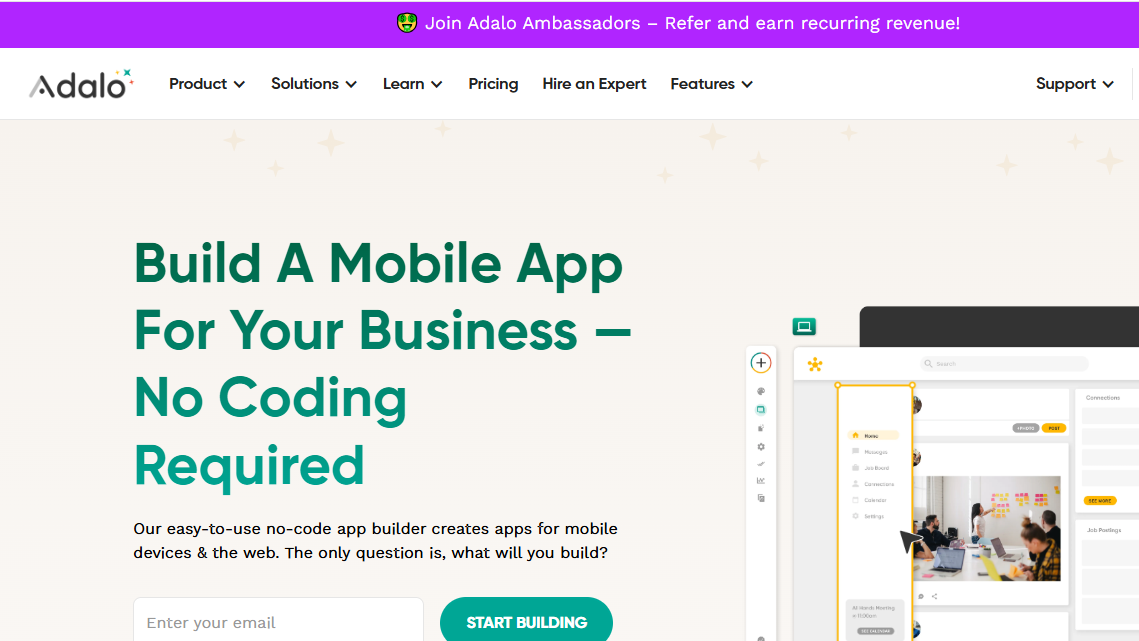Why you can trust TechRadar
We spend hours testing every product or service we review, so you can be sure you’re buying the best. Find out more about how we test.
Adalo is one of the popular no-code app builders that you can use to create mobile and web apps without writing any code. The platform offers a rich set of features and an intuitive interface that help make it a compelling option for anyone looking to roll out apps quickly.
In this review, we’ll examine Adalo’s features, interface, ease of use, how it stacks up against the competition, and more to help you determine whether it’s the right option for you.
Adalo: Features
Adalo offers a wide range of features that help make it stand out among its no-code peers.
For starters, Adalo offers a variety of pre-designed templates for different types of apps, such as food ordering apps, ecommerce apps, coaching apps, appointment apps, and more. These templates are customizable and can help you save a lot of design time.
One of its core user experience features is its intuitive drag-and-drop builder. You can use it to add all kinds of elements and user interface (UI) components without writing any code. Adalo offers dozens of commonly-used components, including buttons, text, lists, images, forms, and navigation bars. You simply drag elements from an organized side menu and place them wherever you want inside your app.
Furthermore, Adalo also has a component marketplace that lists even more components that help make your app more professional. Here you’ll get everything from integrations with third-party services like Stripe for payment processing to user authentication with Google, and Apple, as well as things like QR code generators, in-app purchase widgets, and more.
Adalo also integrates with popular third-party services through Zapier. This allows you to connect your apps with tools like Gmail, Google Sheets, Slack, and others.
Best of all, you can use Adalo to create both mobile and web apps with responsive design features, which helps your apps look great whether on mobile devices, tablets, and desktops. And once you’ve designed and tested your app, Adalo will also help you publish it directly to both Google Play and Apple’s App Store.
Adalo: Interface and Ease of Use
Adalo’s interface is designed with non-technical users in mind. The builder is intuitive and logically organized, with panels and menus clearly arranged in sections to ease navigation.
The platform has a clean and straightforward dashboard, from where you can create new apps with just a few clicks.
You can use Adalo’s app designer to build your app’s UI by simply dragging and dropping elements. When you select a component, the designer lets you customize its properties to help you tailor their appearance and functionality, and resize and position it as required. You can also easily assign actions to components, for example, to navigate to a different screen.
You can also easily add multiple screens for your app, such as a login screen, a home screen, and more, and switch and customize them individually. Adalo provides a built-in preview mode that allows you to test your app and see how it looks and functions on a simulated device.
Adalo: Integration and Extensibility
As we’ve mentioned before, Adalo offers a component marketplace where you can download additional components. The marketplace lists both free and paid components.
Adalo also supports a variety of third-party integrations, which will help expand an app’s functionality and connect with other popular tools and services. For instance, Adalo integrates with Stripe, which enables you to set up payment systems inside your apps.
The highlight is the platform’s integration with Zapier that expands Adalo’s connectivity to thousands of other apps that it doesn’t support natively. Thanks to this integration, you can automate workflows and transfer data seamlessly between Adalo and all kinds of external services such as Google Sheets, Slack, Trello, SendGrid, Salesforce, and thousands more.
Furthermore, advanced users can also create custom actions to connect with external APIs for more control, and functionality.
Adalo: Deployment and Maintenance
When it comes to web apps, you can use Adalo to literally deploy them with a single click. Once your web app is ready, you can deploy it directly as a web app under Adalo’s subdomain, or in a custom domain of your own.
Adalo also allows you to publish your apps as native mobile apps on both iOS and Android app stores. But going about this is a bit more involved than deploying a web app as this requires following the respective store’s submission guidelines, which includes creating developer accounts on Apple’s Developer Program and Google Play Console, and submitting the apps for review.
When it comes to updating the apps, any changes made to the web apps are reflected immediately. For iOS and Android mobile apps, updates must go through the usual process of creating a new build, before submitting it to the app stores for approval. You can also integrate Adalo with One Signal via Zapier, for instance, to send push notifications about updates to users.
Adalo: Pricing and Documentation
Adalo offers several pricing tiers, catering to different users from individuals creating simple apps to businesses that need advanced features and scalability.
Adalo’s Free Plan limits you to creating and deploying a single app. As a free user, you can use Adalo to build web apps, but can’t build and publish mobile apps to the Apple App Store or Google Play Store. Also, apps built on the free plan display Adalo branding.
Adalo pitches the Free Plan as a starting point for individual app designers who want to build simple web apps. You can also use it to explore the platform and its capabilities, before diving into one of its paid plans.
The Starter Plan costs $45/month and gives you the ability to connect your app to a custom domain. You can also use it to design and publish mobile apps. Then there’s the Professional Plan that costs $65/month and comes with enhanced functionality for larger projects, and offers full support for custom API integrations. There’s also the Team Plan that costs $200/month and is designed with collaborative features to help larger teams work together on an app.
In terms of documentation, Adalo provides lots of detailed guides and step-by-step tutorials to help users navigate the platform, learn its features, and build functional apps. There’s also Adalo App Academy that lists over 70 courses covering all aspects of creating apps.
In addition to written documentation, the platform also offers a wide array of video tutorials on its YouTube channel. You can seek support from Adalo’s active community forum, and if you’re on one of the paid plans you can also send your queries directly to Adalo.
Adalo: The competition
Adalo operates in a crowded market of no-code app builders. Some of its main competitors include Thunkable, Glide, and Bubble. Each platform has its strengths and is suited for different types of projects.
The best thing Adalo has going for it is its intuitive drag-and-drop interface, which makes it beginner-friendly. You get the same with Thunkable, which is also designed primarily to build mobile apps.
Bubble too has an easy to navigate interface, and although it offers more advanced customization for full-stack development, it has a steeper learning curve than Adalo. Like Thunable, Bubble too is a good option for creating complex apps, but this also makes them both overkills for users with simpler needs.
Also, while you can use Bubble to create mobile apps, it’s primarily a no-code platform for building web apps. Then there’s Glide, which too can create both web and mobile apps. However it’s designed to quickly turn spreadsheets into simple and functional apps.
Adalo: Final Verdict
Adalo is a powerful and user-friendly no-code app builder that strikes an excellent balance between ease of use and functionality. One of its strongest suites is its ability to create both mobile and web apps without writing any code.
Its drag-and-drop interface, plethora of pre-built components, and integrations with third-party services make it an excellent choice, whether you are a non-technical user, an individual developer, or even small and large businesses. Adalo offers enough flexibility to allow you to quickly prototype, and design a minimum viable product (MVP) to validate your app, as well as build more advanced apps.
While it faces competition from other no-code platforms, Adalo’s ease of use and versatility make it a strong contender in the no-code app builder market.
All things considered, Adalo’s primary strength lies in its accessibility, which makes it a great starting point for anyone venturing into the world of app development.
Read the full article here











